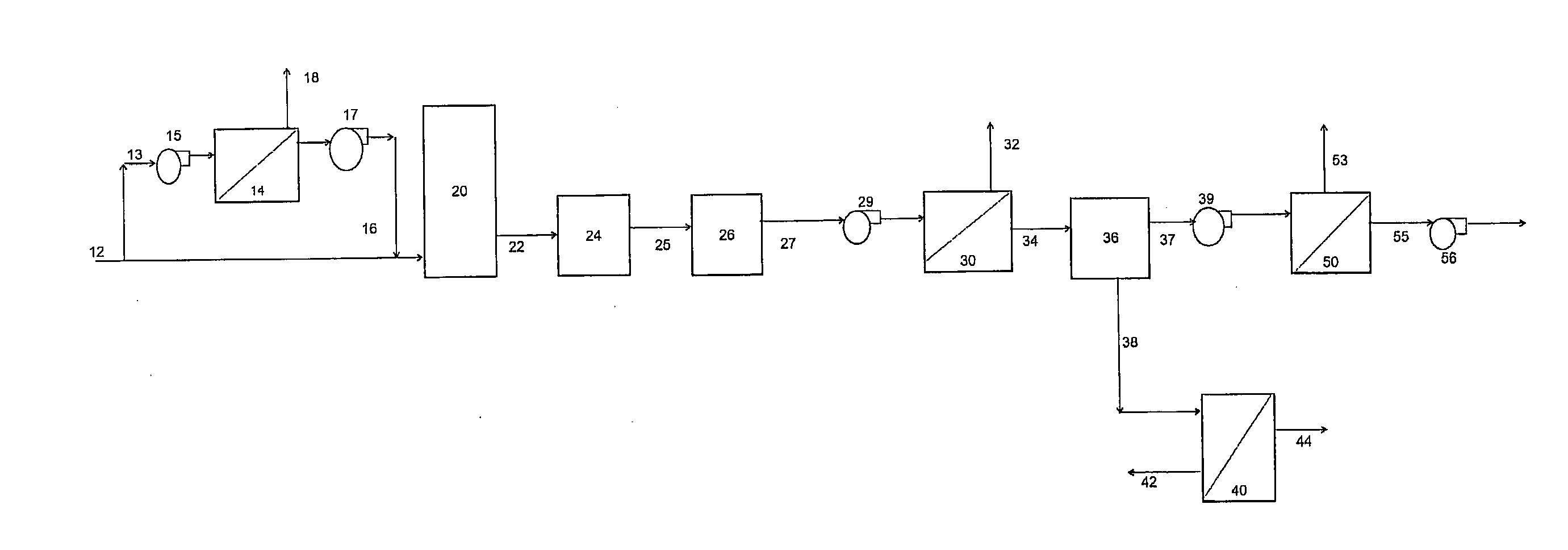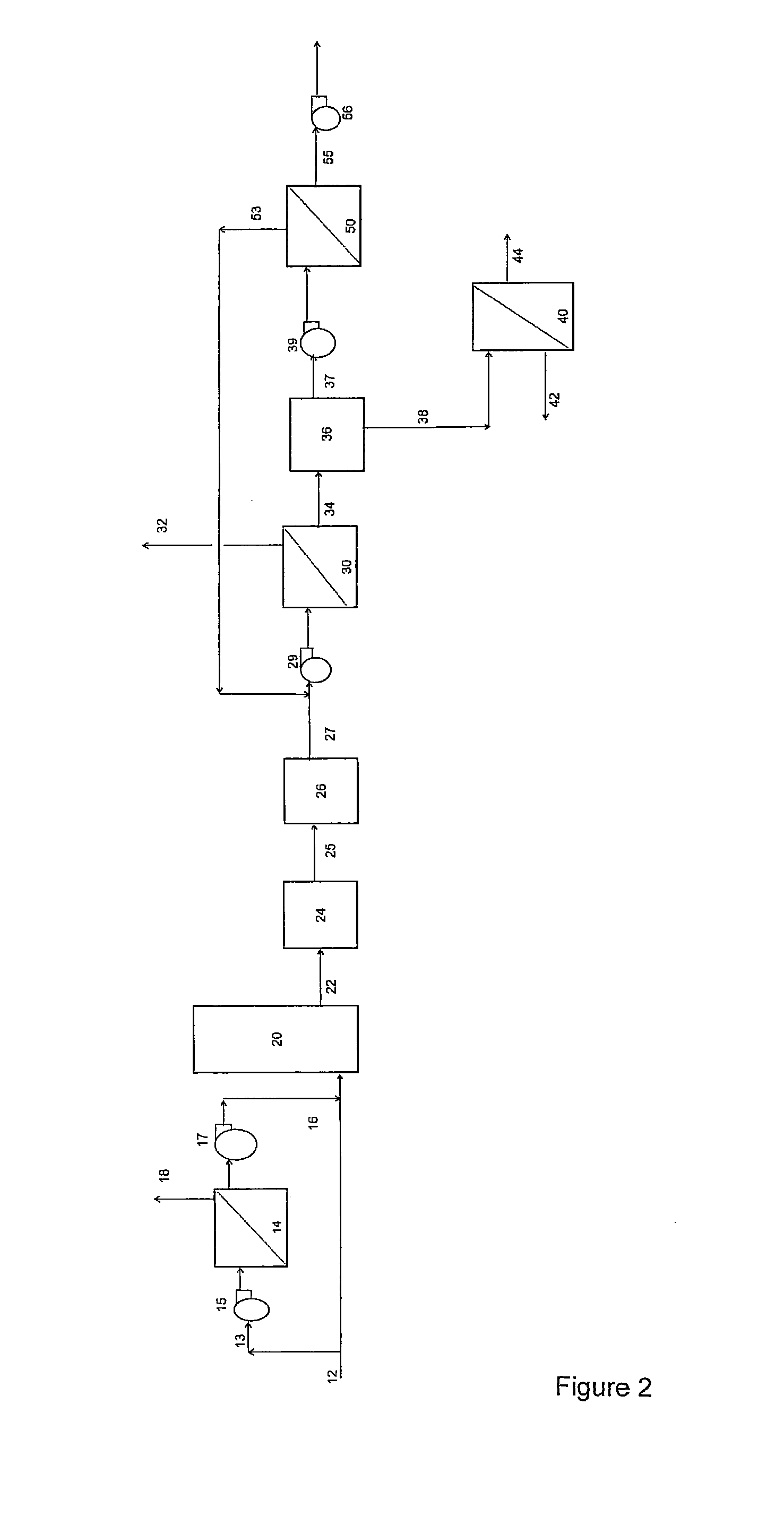Method for the separation of gases
a gas separation and gas technology, applied in the field of improved gas separation methods, can solve the problems of significant energy and maintenance costs to the process operating costs, inability to achieve practical solutions for algae, and low cosub>2 /sub>permeability of membranes, so as to reduce the area of membranes, improve the permeability of membranes, and reduce the cost
- Summary
- Abstract
- Description
- Claims
- Application Information
AI Technical Summary
Benefits of technology
Problems solved by technology
Method used
Image
Examples
example 1
[0221]Example 1 demonstrates the application of a 2 stage membrane separation process as shown in FIG. 1. However, as the process was operated at room temperature, no gas cooling step was required. The feed gas stream, comprised a bottled gas mixture of 85% (v / v) N2, 10% (v / v) CO2, and 5% (v / v) O2 and was passed through a first membrane separation system, comprising one spiral wound polydimethyl siloxane membrane. The permeate stream, was collected using a vacuum pump, and pumped through a membrane purification system, comprising one spiral wound polydimethyl siloxane membrane. The final permeate (purified CO2 stream), was collected using a second vacuum pump. Both membranes had a CO2 permeability of approximately 4000 Barrer and a CO2 / N2 selectivity of approximately 11. The 2 stage membrane separation step achieved approximately 86% CO2 (v / v) purity, with a total CO2 recovery of approximately 83%.
[0222]The results of this test are provided in Table 1.
TABLE 1Stream No2734325553Strea...
example 2
[0223]Example 2 demonstrates the application of a 2 stage membrane separation process as shown in FIG. 1. However, as the process was operated at room temperature, no gas cooling step was required. The feed gas, stream, comprised a bottled gas mixture of 85% (v / v) N2, 10% (v / v) CO2, and 5% (v / v) O2 and was passed through a first membrane separation system, comprising one spiral wound polydimethyl siloxane membrane. The permeate, stream, was collected using a vacuum pump, and pumped through a membrane purification system comprising one hollow fibre polyimide membrane. The final permeate (purified CO2 stream), was collected using a second vacuum pump. The polydimethyl siloxane membrane had a CO2 permeability of approximately 4000 Barrer and a CO2 / N2 selectivity of approximately 11, while the polyimide membrane had a CO2 permeability of approximately 500 Barrer and a CO2 / N2 selectivity of approximately 23. The 2 stage membrane separation step achieved approximately 93% CO2 (v / v) purity...
example 3
[0226]Example 3 demonstrates the application of a 2 stage membrane separation process as shown in FIG. 2, in which a slip stream of exhaust gas, from a natural gas fired combustion process was pumped through a first membrane separation system, comprising one spiral wound polydimethyl siloxane membrane. The permeate, was cooled in a gas cooler, upstream of a vacuum pump, and then pumped through a membrane purification system comprising one spiral wound polydimethyl siloxane membrane. The final permeate, was collected using a second vacuum pump. The reject gas from the membrane purification system, was recycled to the feed of the first membrane separation system.
[0227]Both membranes had a CO2 permeability of approximately 4000 Barrer and a CO2 / N2 selectivity of approximately 11. The 2 stage membrane separation step achieved approximately 92% CO2 (v / v) purity in the final permeate stream, with a total CO2 recovery over 90%.
[0228]The results of this test are provided in Table 3.
[0229]Th...
PUM
 Login to View More
Login to View More Abstract
Description
Claims
Application Information
 Login to View More
Login to View More - R&D
- Intellectual Property
- Life Sciences
- Materials
- Tech Scout
- Unparalleled Data Quality
- Higher Quality Content
- 60% Fewer Hallucinations
Browse by: Latest US Patents, China's latest patents, Technical Efficacy Thesaurus, Application Domain, Technology Topic, Popular Technical Reports.
© 2025 PatSnap. All rights reserved.Legal|Privacy policy|Modern Slavery Act Transparency Statement|Sitemap|About US| Contact US: help@patsnap.com



